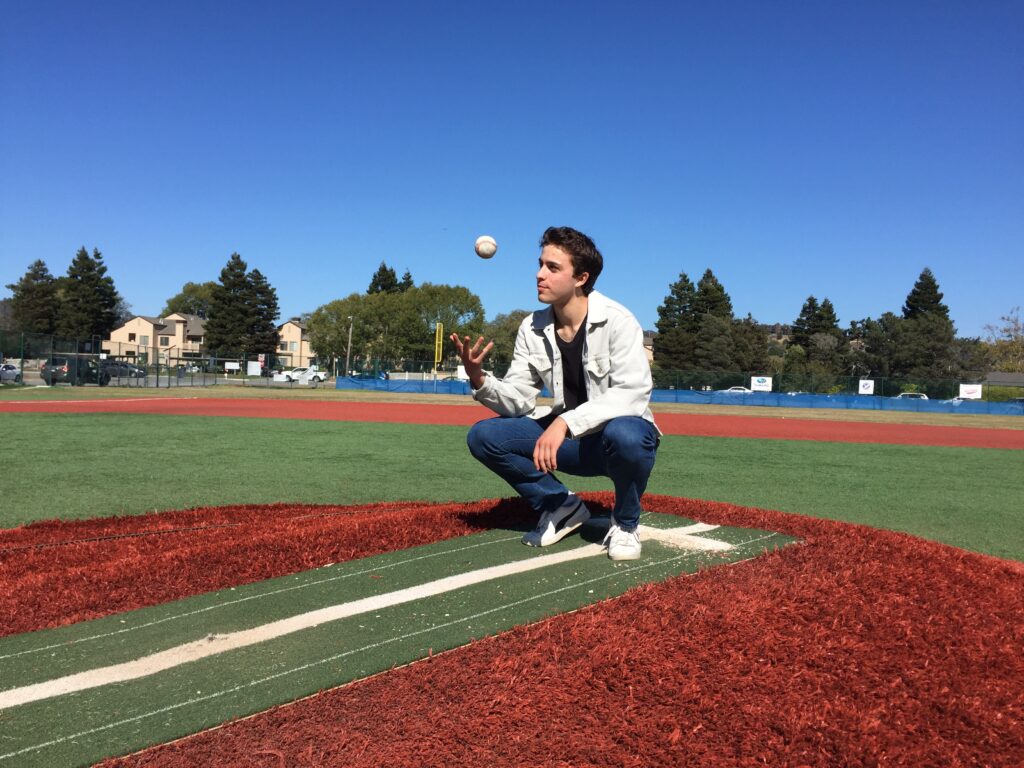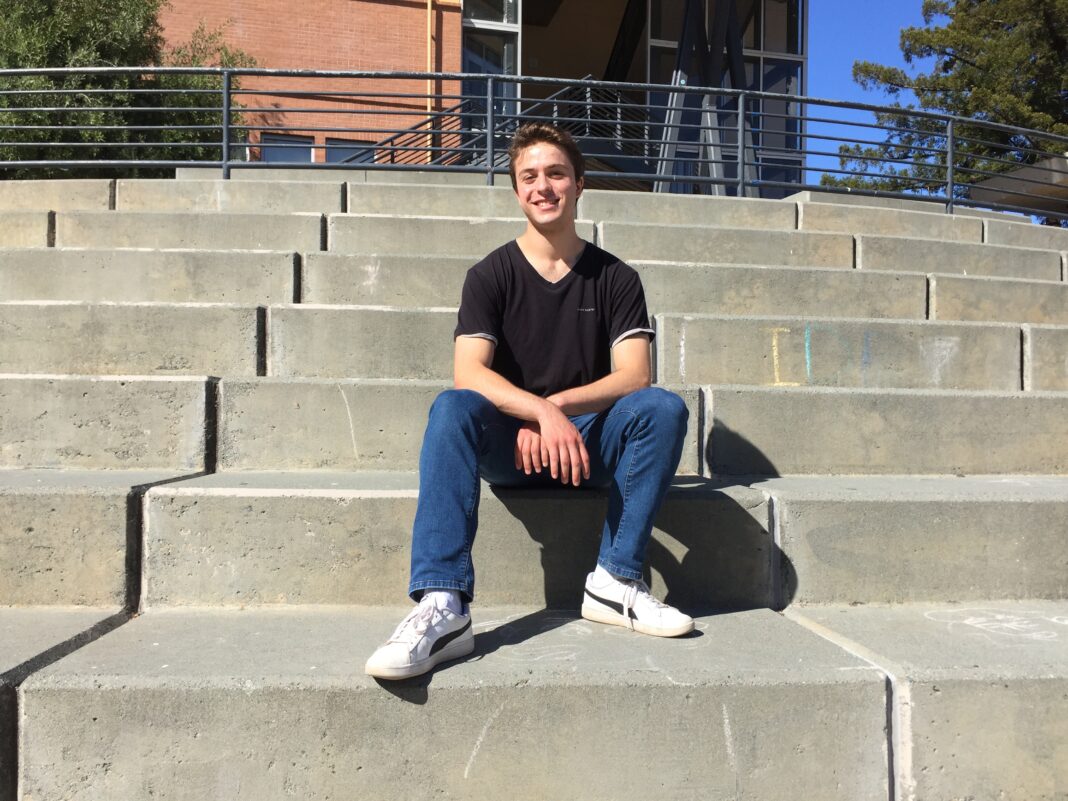A Mill Valley teen made the grade with a creative three-minute video, last month reaching the finals of a prestigious international science competition. Up for grabs is a $400,000 grand prize.
Ari Katz, 18, a senior at Tamalpais High School, wrote, produced and starred in The Shape of the Universe, a video aiming to explain complex physics concepts in a way everybody can understand.
The judges of the 2021 Breakthrough Junior Challenge competition agreed Katz accomplished his goal, earning him a spot among the 16 finalists. Not an easy feat, with more than 3,400 students from around the world entering the competition.
When Katz, a science enthusiast, first heard about the science competition from a family friend, he knew he wanted to enter. And he didn’t have to think long before he came up with a topic.
“I’ve been thinking about the shape of the universe for many years, because I am really in love with physics,” Katz said.
The specifics for Katz’s video began germinating when his older cousin, who is in the process of earning a doctorate in mathematics, taught him about topology, which is the study of properties preserved through the deformation of objects. While all this advanced science and math might go over the heads of many folks, Katz dug into the material. He researched the concept and applied topology to physics.
“Topology for the universe has been very well thought out,” Katz said. “I was quite astonished that it would be possible to think about such a grand subject. Then, I thought that making a video about it would get others excited about it like I was.”
Voila. The Shape of the Universe video began taking, well, shape.
Once Katz had the theory down, he created an animated ant critter, Antonio, and some cool graphics to represent gravity and dark energy, a mysterious property of space that may play a role in the accelerating rate of the expansion of the universe.
Antonio stands in Katz’s hand and asks him questions about the shape of the universe. Katz decided on Antonio because he could talk to the creature, who was small enough not to be distracting. By adding another voice, Katz gave the video contrast and also made it more human. Rather than simply lecturing, Katz wanted to use Socratic dialogue to discuss the complex concepts in the video and inspire the viewer. Antonio is the best way to do that, Katz said.
“In some sense, Antonio is the audience I’m kind of holding in the palm of my hand,” Katz said. “It’s very engaging because it keeps the focus, but it also gives me the chance to second guess myself. From the very start, it’s a ping pong back and forth, trying to figure out how to answer the question Antonio comes up with.”
Katz also gave serious consideration to the various locations used in the video and how colors could portray overarching concepts. Green represented gravity, and red symbolized dark energy.
“Gravity and dark energies, as far as we know, seem to be perfectly balanced,” Katz said. “It’s a profound thing—one in infinity. It’s what we see all around us.”
The elements Katz brought together in the Shape of the Universe allow the viewer to grasp the complicated science involved, which is the purpose of the seventh annual Breakthrough Junior Challenge. Students, ages 13 to 18, submit original videos, up to three minutes long, on a concept or theory in life sciences, physics or math, according to the Breakthrough Foundation. The videos are judged on the student’s ability to communicate the idea in “engaging, illuminating, and imaginative ways.”
The $400,000 prize for the Breakthrough Junior Challenge includes a $250,000 scholarship, a $100,000 science lab for the winner’s school and $50,000 for the science teacher.
The champion will be chosen in November by a selection committee of prominent people in the science and math fields, including astronauts, professors and authors. Katz is especially proud to have earned a spot in the finals this year, as several of his personal heroes are serving as judges.
“Terrence Tao, one of the judges, is regarded as the greatest mathematician of today,” Katz said. “Having known that he saw my video is quite an honor.”

Katz, a young Renaissance man, is quite accomplished in a variety of fields. Currently, he’s taking ballet classes and studying physics at Marin Community College. In his leisure time, he enjoys playing the baritone saxophone, listening to jazz and producing videos.
It’s not surprising to learn Katz plans on becoming a professor one day—specifically a theoretical physics professor. He developed a taste for teaching while working as a math tutor for middle school students. Currently in the process of applying to colleges, Katz’s list includes UC Berkeley, Stanford, MIT and a few other schools, all which would be lucky to grab him.
The teachers who taught Katz over the years played a large role in his love for physics and science. Katz credits Simon McBride, chemistry teacher at Tam High, with helping him hone his ability to tutor others. McBride will be awarded $50,000 if Katz wins the competition.
“Mr. McBride is a great chemistry teacher,” Katz said. “He taught me [that] when you teach in a science class, if you bring in the humanity aspect, it makes learning a more enjoyable experience. You learn at a more natural pace. I took that to heart.”
Grateful for what he’s learned from his teachers, Katz wants to share some words of wisdom for younger science enthusiasts. He especially wants young students to dismiss any fears they may have of studying science—because he didn’t feel confident in the beginning, either.
“If you’re interested in science and you feel like you’re not good enough to do science, I strongly encourage you to do it,” Katz said. “It would be a shame to let fear get in the way. The thing so rewarding about science is that regardless of how much you learn, there’s always an infinite expanse that you still have to travel. There’s the perspective that you have that no other person is going to have. I definitely urge every young person to keep learning what they want to learn about. Go all the way, and see what happens.”











